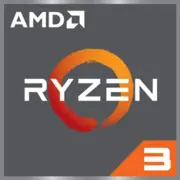AMD Ryzen 3 PRO 5350G

AMD Ryzen 3 PRO 5350G: Budget APU for Office, Multimedia, and Light Gaming
Relevant as of April 2025
Main Features: Cezanne in a Compact Form Factor
The AMD Ryzen 3 PRO 5350G processor, released in 2021, remains relevant in 2025 due to its balance of price and performance. Built on the Zen 3 architecture (codename Cezanne) and TSMC's 7nm FinFET process, it combines 4 cores and 8 threads with a base frequency of 4.0 GHz (Turbo up to 4.4 GHz). Key features include:
- Integrated Radeon™ Graphics with 7 Compute Units (448 stream processors) and a frequency of up to 1700 MHz.
- 8 MB of L3 cache to accelerate multithreaded tasks.
- Support for SMT (Simultaneous Multithreading) and Precision Boost 2 technology.
- TDP of 65 W: low power consumption and minimal heating.
In Geekbench 6 tests (Single-Core: 1766, Multi-Core: 5094), the processor demonstrates solid speed in office applications and browser tasks. The integrated graphics handle games on low settings (for example, CS2 — 50-60 FPS at 720p) and video processing at resolutions up to 4K.
Compatible Motherboards: AM4 Socket and Flexible Choices
The Ryzen 3 PRO 5350G uses the AM4 socket, allowing you to choose from a wide range of compatible motherboards:
- Chipsets:
- B550 — the optimal choice (PCIe 4.0, NVMe support, USB 3.2 Gen 2). Examples: ASUS TUF B550-Plus ($110–130).
- A520 — a budget option, but lacks overclocking and PCIe 4.0 (Gigabyte A520M DS3H — $75–90).
- X570 — overkill for this CPU, but suitable for future upgrades (MSI X570-A Pro — $150–170).
Important: Before purchasing, check BIOS compatibility. For motherboards from 2020-2021, a firmware update may be required.
Memory: DDR4 with an Emphasis on Dual-Channel Mode
The processor supports DDR4-3200 MHz (maximum volume — 128 GB). For optimal performance:
- Use a dual-channel configuration (2×8 GB or 2×16 GB).
- Optimal timings: CL16 or CL18 (for example, Kingston Fury Beast DDR4-3200 CL16 — $50 for 16 GB).
- Integrated graphics benefit from high RAM frequency: the difference between DDR4-2666 and DDR4-3200 in games can reach 15–20%.
Important: DDR5 is not supported — a drawback for those planning to transition to new standards.
Power Supply: Minimum Requirements
With a TDP of 65 W, the processor does not require a powerful PSU:
- For a system without a discrete graphics card, a power supply of 300–400 W will suffice (for example, be quiet! System Power 10 400W — $45).
- If planning to install a GPU (for example, Radeon RX 6600), choose a PSU of 500–600 W with 80 Plus Bronze certification (Corsair CX650M — $70).
Tip: Don’t skimp on the quality of the PSU. Cheap models may function unreliably under peak loads.
Pros and Cons
Strengths:
- Low power consumption and quiet operation even with the stock cooler.
- Integrated graphics for office tasks and light gaming.
- Affordable price ($120–150 in 2025).
- Support for PRO technologies (encryption, remote management).
Weaknesses:
- Only 4 cores: in 2025, this is limited for rendering or streaming tasks.
- No PCIe 4.0 on A520 chipsets.
- Lack of DDR5 support.
Usage Scenarios
1. Office and Study: Quick work with documents, browsers (20+ tabs), Zoom/Teams.
2. Multimedia: Watching 4K videos, editing in DaVinci Resolve (projects up to 1080p).
3. Light Gaming: Fortnite (720p, Low — 60 FPS), Minecraft (1080p, 90 FPS), GTA V (720p, Medium — 45–50 FPS).
4. Home Server/Mini PC: Low power consumption and support for ECC memory (on PRO models).
Real example: A build for a home theater (ASRock DeskMini X300 case, 16 GB DDR4, 512 GB SSD) will cost around $300–350.
Comparison with Competitors
- Intel Core i3-13100T ($140): Better for single-threaded tasks (Geekbench 6 SC: 1980), but weaker in multithreaded (GB6 MC: 4800) and lacks Vega-level integrated graphics.
- Ryzen 5 5600G ($170–180): 6 cores/12 threads, Vega 7 graphics (more CUs). A choice for those who need more power for an additional $20–30.
- Apple M1 (in Mini PC): More energy-efficient but limited compatibility with Windows applications.
Building Tips
1. Motherboard: B550 for a balance of price and functionality.
2. Memory: 16 GB DDR4-3200 CL16 as a minimum for multitasking.
3. Cooling: The stock cooler is sufficient, but for quieter operation, consider a Deepcool Gammaxx 400 ($25).
4. Storage: NVMe SSD (for example, WD Blue SN570 500 GB — $45) for faster boot times.
5. Upgrade: If planning to install a discrete graphics card, choose a case with good ventilation.
Conclusion: Who is the Ryzen 3 PRO 5350G Suitable For?
This processor is an ideal choice for:
- Office PCs with future-proofing in mind.
- Budget home systems (net tops, media centers).
- Students and users who do not need top-tier graphics.
- Enthusiasts building compact systems.
As of 2025, the Ryzen 3 PRO 5350G remains a cost-effective option due to its low price, energy efficiency, and integrated graphics. However, for serious workloads, it is better to consider 6-core models.
Basic
CPU Specifications
Memory Specifications
GPU Specifications
Miscellaneous
Benchmarks
Compared to Other CPU
Share in social media
Or Link To Us
<a href="https://cputronic.com/cpu/amd-ryzen-3-pro-5350g" target="_blank">AMD Ryzen 3 PRO 5350G</a>